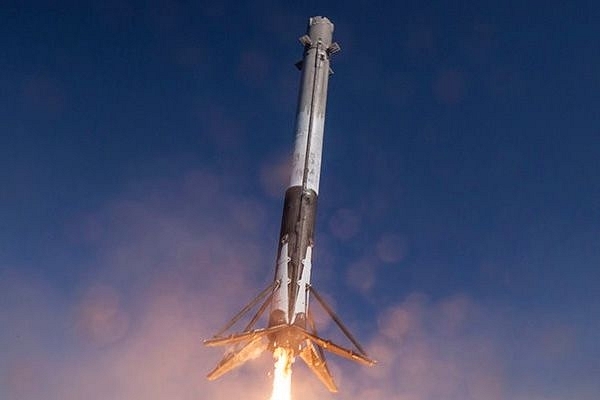
ISRO Should Kick On With Developing Reusable Launch Technology
There is an opportunity for ISRO to compete even strongly in the future – the key to it lies in developing the reusable launch technology.
The Indian Space Research Organisation (ISRO) in November launched the GSLV Mk-III D2 successfully, with the GSAT-29 communication satellite on board. It has made a commendable achievement with its new launcher, which earlier had been something of a dream for India. Now it will now allow the country to place satellites as heavy as 4 tonnes into the geosynchronous transfer orbit (GTO).
Apart from the launch of heavy satellites into the GTO, India plans to use GSLV Mk-III for the launch of two critical missions – Chandrayaan-II, which involves soft landing on the lunar surface, and the human spaceflight mission, which the ISRO plans to undertake sometime before 2022.
Getting Ahead
ISRO has always been at the forefront of developing technology accessible to the ordinary folk. Unlike other space agencies, ISRO is cost-conscious and result-oriented and it’s been able to achieve all that it has with a modest annual budget of $1.7 billion a year. Thanks to its tried-and-tested workhorse, the Polar Satellite Launch Vehicle (PSLV), it is now the most preferred agency for launching small satellites.
However, heavier satellites require the Geosynchronous Satellite Launch Vehicle (GSLV). The development of the homegrown cryogenic C25 stage engine that uses extremely low-temperature propellants Liquid Hydrogen (LH2) at 20 Kelvin ( -253 C) and Liquid Oxygen (LOX) at 80K (-193 C) is remarkable and in line with ISRO’s efforts to turn GSLV as its next go-to machine. According to ISRO, an improved version of these engines would feature in its Chandrayaan-II and Adithya missions in the future.
However, casting GSLV Mk-III alone as a soldier in the space arena would be misguided. If ISRO needs to compete well in the domain of space, it must focus on developing the reusable launch vehicle (RLV).
ISRO is in the league of three space agencies that has the potential of driving the reusable launch vehicle project into the future, the other two being SpaceX and Blue Origin. SpaceX has proven experiences in reusing parts of rockets while Blue Origin lags with multiple vertical ascents and landing tests. ISRO, for its part, has successfully completed its testing of the RLV in 2016.
Although the European Space Agency, the Russian Roscosmos, and the Chinese National Space Administration all have plans to venture into the reusable launch vehicle market, none of them has been reported testing prototypes, like in the case of ISRO, or has mastered reusable technology like SpaceX.
The Competition
SpaceX was the first to work on reusable launch systems. Kicked off in 2002, it has completed over 60 launches and 30 landings. It is arguably the first company in the world that has complete data sets for landing rockets vertically. Over the years, the private space company has developed the Falcon reusable launch family, including the extremely capable Falcon 9 (23 tonnes) and Falcon Heavy (64 tonnes).
Blue Origin, founded by billionaire Amazon chief executive Jeff Bezos, initially focused on developing a small, reusable suborbital rocket called New Shepard. The company made history in November 2015 when it launched and landed the New Shepard rocket – it was the first time that a rocket booster returned from space for a vertical landing.
However, in terms of launches, Blue Origin has a lot of ground to cover to match up to SpaceX. What makes it a contender anyway, howver, is its BE-4 engine, which is more powerful than the Merlin engines used in the Falcon 9.
Interestingly, ISRO, a government organisation unlike the other two, can still hold its own in this space – a successful Mars Orbiter Mission on the first try and 104 satellites in a single launch make up only the recent portfolio of India’s space agency. Now, against the backdrop of the successful launch of the heaviest ever GSAT-29 and the most recent GSAT-11, codenamed “Big Bird”, ISRO’s efforts to develop reusable launch vehicles should gain places on the priority list.
In 2016, the RLV prototype was successfully launched and valuable data was collected. RLV-TD (technology demonstration) had a similar design as that of a space shuttle – it launched horizontally and had a colossal valley covered with heat-resistant material for high-velocity re-entry and landing. Though the current design will bring down the cost per launch significantly, it limits the RLV’s use case to earth. Unlike SpaceX, this design will not work on the Moon or Mars as there is no runway or atmosphere for winged horizontal entry. Moreover, a commercially viable RLV is 12 years away with the launch planned at 2030.
With its strong track record, ISRO can be a formidable contender in the scheme of space launches in the future. By adjusting its priorities and throwing its weight firmly behind its reusable launch programme, the RLV could disrupt the launch market as well as enable manned missions and launches of sophisticated communication satellites weighing more than 5 tonnes.
ISRO’s continued success should be translated into more growth by investing more on engineers and equipment to develop rockets comparable to Falcon 9.